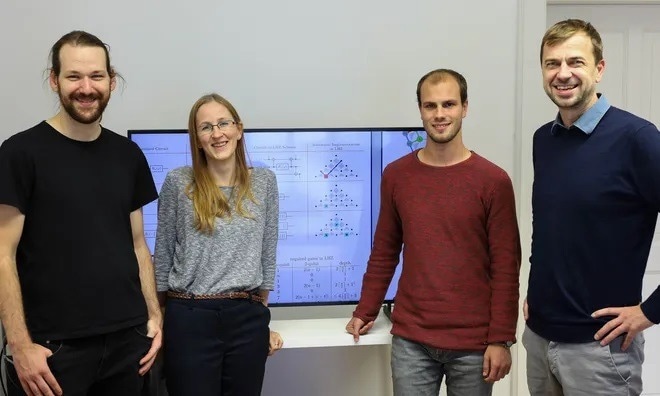Reviewed by Mila PereraOct 31 2022
Currently, the computing power of quantum systems is slow, and it is proving to be a huge challenge to increase its power. A team of University of Innsbruck physicists has presented a new design for a universal quantum computer that surpasses such confines and could soon be the foundation of advanced quantum computers.

The team led by Wolfgang Lechner (right): Kilian Ender, Anette Messinger, and Michael Fellner (from left). Image Credit: University of Innsbruck
Quantum bits (qubits) in a quantum computer act as a computing unit as well as a memory. Since it is not possible to copy quantum data, it cannot be stored in memory like a conventional computer. Owing to this constraint, all qubits in a quantum computer should be able to interact with one another. This remains a significant challenge for constructing robust quantum computers.
In 2015, theoretical physicist Wolfgang Lechner and Peter Zoller and Philipp Hauke investigated this constraint and suggested a new architecture for a quantum computer, currently labeled as LHZ architecture after the authors.
This architecture was originally designed for optimization problems. In the process, we reduced the architecture to a minimum in order to solve these optimization problems as efficiently as possible.
Wolfgang Lechner, Theoretical Physicist, Department of Theoretical Physics, University of Innsbruck
The physical qubits in this architecture do not signify individual bits but encrypt the relative coordination between the bits.
This means that not all qubits have to interact with each other anymore.
Wolfgang Lechner, Theoretical Physicist, Department of Theoretical Physics, University of Innsbruck
Along with his team, Lechner has demonstrated that this parity concept is also ideal for a universal quantum computer.
Complex Operations Are Simplified
Parity computers can conduct operations between two or more qubits on a solo qubit.
Existing quantum computers already implement such operations very well on a small scale. However, as the number of qubits increases, it becomes more and more complex to implement these gate operations.
Michael Fellner, Physicist, Department of Theoretical Physics, University of Innsbruck
Michael Fellner is a part of Wolfgang Lechner's team. In two articles published in Physical Review Letters and Physical Review A, the Innsbruck team demonstrate that parity computers can, for instance, carry out quantum Fourier transformations, a central building block of numerous quantum algorithms, with considerably fewer computation steps and thus more rapidly.
“The high parallelism of our architecture means that, for example, the well-known Shor algorithm for factoring numbers can be executed very efficiently,” Fellner explains.
The new idea also provides hardware-efficient error rectification. Since quantum units are highly vulnerable to disturbances, quantum computers must constantly rectify errors. Substantial resources must be dedicated to guarding quantum data, which significantly escalates the number of qubits required.
“Our model operates with a two-stage error correction, one type of error (bit flip error or phase error) is prevented by the hardware used,” states Anette Messinger and Kilian Ender, who are Innsbruck research team members.
At present, there are preliminary experimental methods for this on various platforms.
“The other type of error can be detected and corrected via the software,” Messinger and Ender say.
This would allow the advanced universal quantum computers to be realized with achievable effort. ParityQC, the spin-off company co-founded by Wolfgang Lechner and Magdalena Hauser, is already working in Innsbruck with collaborators from industry and science on potential applications of the new model.
The study carried out at the University of Innsbruck was financially backed by the Austrian Research Promotion Agency FFG and the Austrian Science Fund FWF.
Journal References
- Fellner, M., et al. (2022) Universal Parity Quantum Computing. Physical Review Letters. doi.org/10.1103/PhysRevLett.129.180503.
- Fellner, M., et al. (2022) Applications of universal parity quantum computation. Physical Review A. doi.org/10.1103/PhysRevA.106.042442.